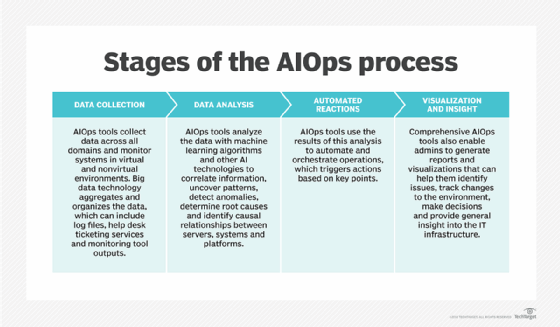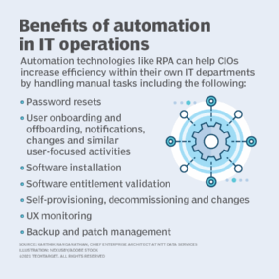NoOps (no operations)
What is NoOps (no operations)?
NoOps (no operations) is a concept that an IT environment can become so automated and abstracted from the underlying infrastructure that there's no need for a dedicated team to manage software in-house.
First coined by research and advisory company Forrester, the term describes the goal of NoOps as to "improve the process of deploying applications" so that "application developers will never have to speak with an operations professional again." Forrester's Mike Gualtieri called DevOps "a step backward" even though, in his short 2011 article, he wrote that he admires its goal to improve application release deployment processes.
Gualtieri argued that NoOps would be better than DevOps in many ways. According to him, NoOps would give application developers the resources they need when they need them by using cloud infrastructure as a service and platform as a service solutions. These modern solutions would accommodate a more business-oriented focus. NoOps can help developers spend more time getting closer to the business, while deploying applications faster and with less disruption.
Some IT vendors claim to have largely achieved NoOps. Yet, few organizations have reached the level of full automation NoOps promotes. True NoOps means a completely automated IT environment that requires absolutely no human involvement. Some experts believe that's impossible to achieve. Others believe it's also undesirable. The idea of NoOps often triggers anger and resistance from operations professionals who fear for the loss of their jobs if more operational responsibilities are given to business units or product teams.
Key drivers of NoOps
Two drivers of NoOps are increasing IT automation and cloud computing. NoOps environments rely on automated, policy-based processes achieved through new initiatives like DataOps, AIOps and DevSecOps.

Early NoOps implementations involved replicating existing systems to the cloud in a lift-and-shift fashion. These cloud-native applications abstracted IT operations from a traditional centralized operations unit to the cloud provider, which then took over activities related to infrastructure provisioning and application deployments. The operations were simply performed by someone else but not automated. For this reason, these early implementations cannot be called truly NoOps.
Today, NoOps tools help to create highly automated IT infrastructure through infrastructure as code, microservices and application programming interfaces. Some tools support automated self-healing of application environments and enable easy automation of system configurations. More organizations are adopting NoOps due to AIOps platforms that can automate IT operations processes by combining big data and machine learning. The best platforms eliminate the need to manually define policies. They can automatically detect configuration changes in real time and even automate entire IT workflows.
Some other tools that facilitate NoOps are the following:
- Enterprise dashboard and analytics tools.
- Container management and orchestration tools.
- Code version control tools.
- Application performance monitoring tools.
- Infrastructure configuration and testing automation tools.
- Digital workflow tools, e.g., ServiceNow.
- Automation platforms with built-in software provisioning, configuration and deployment capabilities, e.g., Ansible.
- Software intelligence platforms for infrastructure monitoring, cloud automation, vulnerability detection and other functions.

Benefits of NoOps
Full NoOps is not possible currently, but to the extent it can be implemented, NoOps can bring many benefits into enterprise environments. One, automation reduces costs and manual management burden. Two, it helps businesses respond to market changes faster to speed up development and accelerate product time to market. Further, automating routine tasks can free up staff to handle higher-value tasks instead of wasting time on manual activities.
DevOps vs. NoOps
NoOps can be contrasted with DevOps, a development approach that blurs the line between development and operations teams so members of each group assume some of the responsibilities of the other. In DevOps, infrastructure experts and software experts coordinate closely so they both have a stake in the other's success.
Teams that adopt DevOps can work together seamlessly to develop high-quality software, resolve issues early, accelerate releases and protect the stability of the infrastructure.
But it's not easy to adopt DevOps, especially in organizations accustomed to siloed development and operations functions. Moreover, DevOps success hinges on cultural change and buy-in from top management, which can be difficult to achieve.
DevOps focuses on continuous feedback and updates. This can be a huge advantage for some teams, helping them put out a high-quality product quickly. However, it can be a disadvantage for teams who cannot keep up with the pace of change or are unable, or unwilling, to be more nimble and fix mistakes rapidly.
In DevOps environments, the operations team handles building and monitoring the infrastructure, configuring hardware and middleware, providing production-equivalent infrastructure for testing, and managing the release management process releases. Generally, operations and development work together to plan capacity, establish failover strategies, and manage performance and scale. Further, operations manages incident response processes and sets up infrastructure security, while development builds security into the application.
NoOps takes DevOps a step further by automating many operational processes, reducing the manual effort required. The idea can be attractive when the functions needed to develop, deploy and manage applications can be automated in the design itself. When this occurs, teams can focus more on innovation, process optimization and business results.
Learn about hyperautomation use cases for IT operations, and explore where NoOps fits in the future of IT ops.







